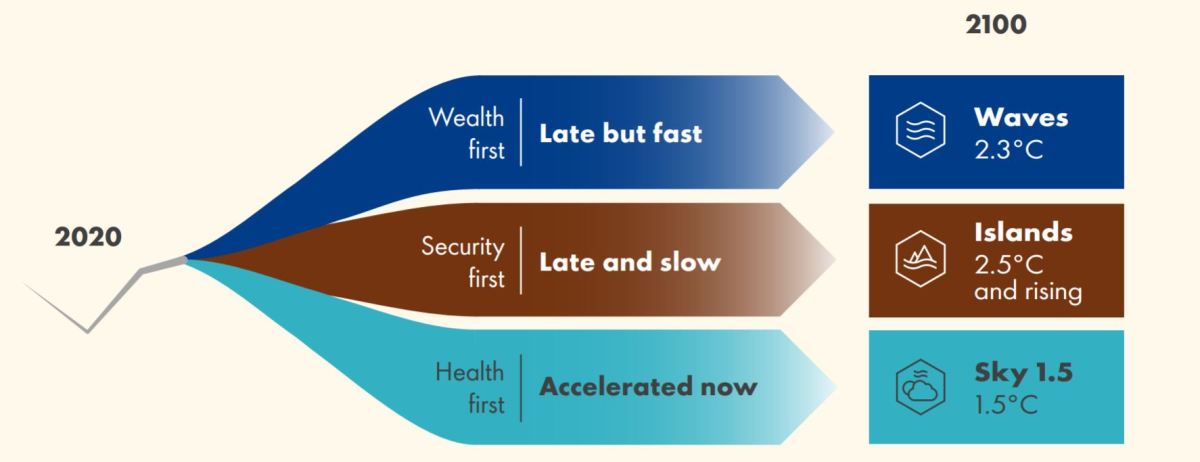
Every few years Shell releases a new set of overarching global energy scenarios and this week marks the launch of our Energy Transformation Scenarios. Three scenarios, namely Waves, Islands and Sky 1.5 explore the energy landscape out to 2100 and reveal very different possible pathways forward. All three are transformational in nature, with net-zero emissions now within sight, albeit on quite different timescales. The story-lines build from a piece of work the scenarios team presented in October last year, Rethinking the 2020s, in which we looked at how the COVID-19 pandemic has reshaped not just 2020 and 2021 but the whole of the decade ahead. How we emerge from the pandemic and where the 2020s take could shape the journey for much of the century ahead. Similarly, as the world emerged from the Great War and Spanish Flu pandemic, the 1920s shaped the future for many decades after.
Compared to the transformations seen over the last 40 years in telecommunications, information technology, travel, consumer goods and many other aspects of modern life, the energy system has seen very little change. When I started my career in Shell in 1980 fossil fuels made up 85% of primary energy, which fell to around 80% by the 1990s, but it has remained roughly at that level ever since. Coal has remained very steady at around 25-28% of primary energy, but natural gas has gained ground relative to oil because oil is hardly used for power generation today and less for home heating than in 1980. By contrast, the new scenarios point to changes ahead. The seeds of change are emerging rapidly as the cost of renewable energy falls, as electric vehicles come of age and as even newer fuel technologies such as hydrogen establish a foothold.
Net-zero emissions is now in our future, but the timing may shift in a range of 80 years, depending on societal pressures, behaviours and geopolitics. The Sky 1.5 scenario reaches net zero carbon dioxide emissions globally, from all sources, by the late 2050s, whereas the Islands scenario doesn’t get there until some time in the first half of the 22nd century. Waves arrives at the goal in 2100. As a result, the temperature outcome in 2100 varies from 1.5 to 2.5C average surface temperature rise vs. 1850-1900, with the Sky 1.5 scenario achieving the goals of the Paris Agreement. So why the differences?
In Waves, the initial response to the crises of 2020 is to repair the economy – wealth first. Other underlying societal and environmental pressures receive less attention initially until their relative neglect provokes backlash reactions. Then, moving quickly, but starting later than required to meet the goals of the Paris Agreement, global society achieves an energy system with net-zero emissions – late, but fast, decarbonisation. Waves is a story that is marked by a deliberate shift away from fossil fuels as a backlash to earlier inaction, rather than a specific focus on managing emissions. As such, carbon capture and storage (CCS) technologies never develop, but then emissions don’t fall as fast as required.
In Islands, governments and societies decide to focus on their own security, with a new emphasis on nationalism threatening to unravel the post-war geopolitical order. Although the normal course of equipment and infrastructure replacement and the deployment of cleaner technologies bring progress and eventually net-zero emissions, the world overshoots the timeline and does not achieve the goals of the Paris agreement – late and slow decarbonisation.
In Sky 1.5, the initial response to the crises of 2020 is to focus on responding to the pandemic and related challenges to public well-being – health first. Lessons learned from shared best practices, alignments of diverse interests and institutional improvements help create a pathway to the health not only of people and society, but also of the environment, including meeting the stretch goal of the Paris Agreement – accelerated decarbonisation now. Sky 1.5 is all about managing emissions, so coal drops out very early, CCS emerges rapidly and land is managed with conservation and carbon in mind.
The Energy Transformation Scenarios

While the headline stories highlight very different directions, it’s the detail within the stories that show the real value in scenario thinking. For example, one might imagine that it is in the Sky 1.5 story that aviation starts to shift away from hydrocarbon fuels, but it is in Waves that it happens first. The push to move on from fossil fuels in Waves sees aviation hydrogen technology emerge in the 2040s. Shipping is even earlier.
In the 1980s Tupolev modified their Tu-154 to run on hydrogen, but no commercial opportunity emerged. Recently Airbus announced that they want to have hydrogen planes available for airlines by 2035. In the Waves scenario hydrogen flights give rise to 120 billion passenger km by 2045, from none in 2040, which would require a fleet of 170 planes based on a well-travelled route such as London to New York. By 2050 Waves sees 1,200 such planes in the air. Although current Boeing / Airbus production capacity is about 1,600 planes per year across all models, it still took Boeing a decade of production to get 1000 787s in the air following its launch. Given the novel nature of hydrogen aviation and the very high safety standards inherent within the industry, a faster roll-out is difficult to contemplate.
Across all three scenarios solar eventually emerges as the biggest single energy source, largely driven by cost considerations. The natural intermittency of solar will be one of the major technical challenges within the energy system, but it can be addressed through long distance grid interconnections, suitable backup generation and energy storage. Shorter duration grid management with battery storage is moving at quite a pace, with good examples emerging in Australia. In late 2017 there was considerable excitement around the installation of the largest battery in the world, a 100MW/129MWh battery paired with the Hornsdale windfarm, about 230km north of Adelaide. But that now seems like a small scale project. Very recently plans were announced for a 1.2 GW battery in the Hunter region of New South Wales. The battery is one of four in a 2 GW battery storage portfolio planned throughout Australia by one consortium. Another recent announcement sees a 250 MW, four-hour duration battery system (1000 MWh) in development at the site of the Torrens Island Power station in South Australia.
The scenarios draw on these types of developments now visible in many parts of the energy system and illustrate how they can be applied to move the whole system towards net-zero emissions. But the pace of change is not a given. The goals of the Paris Agreement can be met given the right confluence of societal, political and economic trends, but nevertheless in all three scenarios net-zero emissions is an eventual outcome and warming is contained at or below 2.5°C. Net-zero emissions now appears to be a question of when, not if, meaning that resolution of the climate issue becomes a focus on the enabling conditions for rapid change and not a question about whether change can happen.
You can visit the Energy Transformation Scenarios here.
Note: Scenarios don’t describe what will happen, or what should happen, rather they explore what could happen. Scenarios are not predictions, strategies or business plans. Please read the full Disclaimer here.



Average Rating